Want to grow your twitter followers responsibly?
Trusted by 50,000 monthly users • since 2009
In the ongoing fight against extremism, the latest battle is unfolding on unfamiliar territory: social media. Across the globe, lawmakers are demanding increased accountability from Facebook and Twitter, whose platforms have been used to share and celebrate hate speech. In January 2018, Germany enacted severe fines for social networks failing to remove illegal and offensive material. In America, evidence has emerged that stoking racial tensions online was an integral part of the Russian campaign to influence the 2016 election. Responding to public outcry, Twitter began enforcing new hate speech rules in 2017, suspending prominent accounts associated with the "alt-right" movement.
Although various hate groups and their leaders command powerful followings, their digital activities remain relatively unknown to most Americans. Who are these extremists, and how do they employ social media to spread controversy and attract followers? In this project, we analyzed and exposed the Twitter activity of 43 American extremists who used the platform to advance their views. Our findings reveal the details of their efforts and demonstrate a painful truth: In the battle for hearts and minds online, many extremists seem to be making a mark.
Most extremists aspire to national visibility online, but the geographical distribution of various hate groups reveals how extreme ideologies have taken root in different regions. According to Southern Poverty Law Center data, white nationalist groups were the most numerous nationwide. Interestingly, black nationalist groups were the second most common type of extremist organization and often existed in close proximity to white nationalist strongholds, such as in some Southern states with long histories of racial tension.
Anti-Muslim groups demonstrated truly national scope, with more than 100 groups scattered from coast to coast. Other extremist causes, by contrast, were relatively contained in geographical terms. For example, our data from Southern Poverty Law Center included just 22 anti-immigrant organizations, and they were largely absent from the geographical middle of the country. They were concentrated in Arizona and Southern California, where a shared border with Mexico has created deep divides in an ongoing immigration debate.
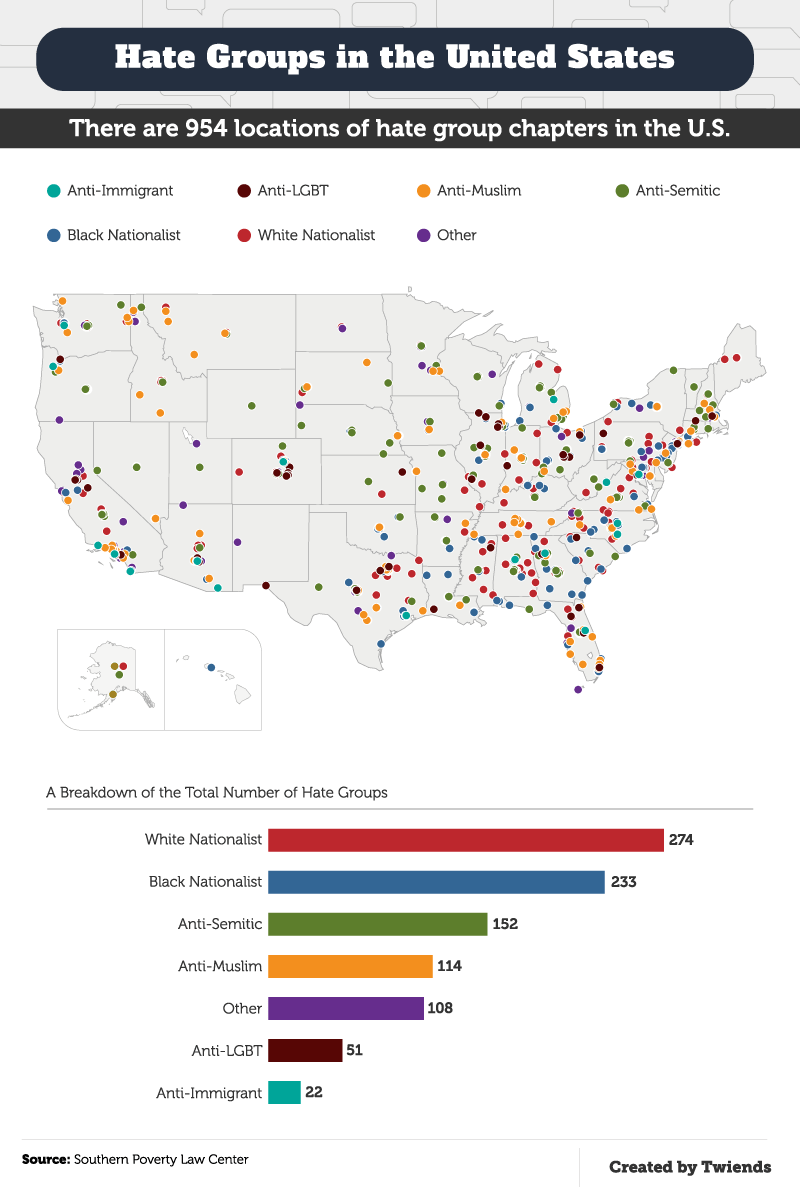
Two of America's tiniest territories managed to account for the lion's share of national intolerance.
The political epicenter of the U.S. is also the country's main well of hateful sentiment, according to our study. Washington, D.C., had an unbelievably high rate of Twitter users that followed hate groups, at 70.6 people for every 10,000 residents. The hate map published by the Southern Poverty Law Center, or SPLC, pinpoints 26 hate groups operating within D.C.'s 177 square kilometers, a good number of which were labeled as group headquarters.
The number of hate group followers in D.C. was nearly five times as high as Delaware, with 15.1 hate group followers per 10,000 residents. Recently, the YWCA Delaware hosted an anti-racism event, aiming to discuss and disempower resurgent hate groups in the community. Among the five states with the highest volume of hate group Twitter followers, the lower three had very similarly sized populations compared to the top two: Indiana, Alaska, and Tennessee all had between 8.7 and 10.5 Twitter followers each per 10,000 residents.
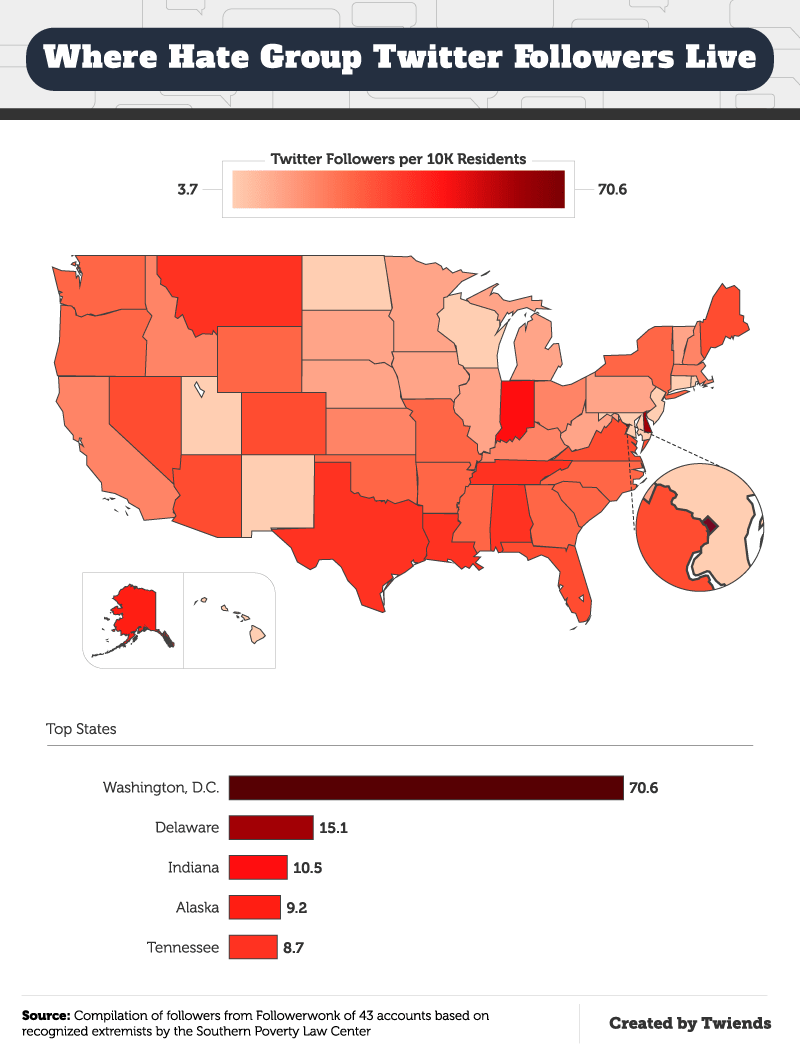
While Delaware has less than 1 million residents, this state was home to the highest number of hate group Twitter members in four of six categories: anti-LGBT, anti-Muslim, black nationalist, and white nationalist. In the summer of 2017, an incident occurred during which two Republican lawmakers in Delaware chose to leave a session in the Senate during Muslim prayer, demonstrating how openly certain xenophobic beliefs can be displayed without meaningful repercussions. Anti-Semitism burned brightest in South Dakota, a state with virtually no Jewish population to speak of. In fact, this state recently acquired its only full-time rabbi. The rabbi was a transplant from New York, which had the second-greatest number of anti-Semitic followers on Twitter. New York also has a uniquely elevated Jewish population, with approximately 1 in 10 residents having Jewish roots.
Meanwhile, in Indiana - the second white nationalist hot spot for Twitter followers - certain members of the community have been showing outspoken support for the white nationalist ideology. One such individual is Matthew Heimbach, dubbed "the next David Duke," who has rallied behind the cause as a speaker at major events and producer of ideological propaganda. A total of 30 hate groups were identified in this state by the SPLC.
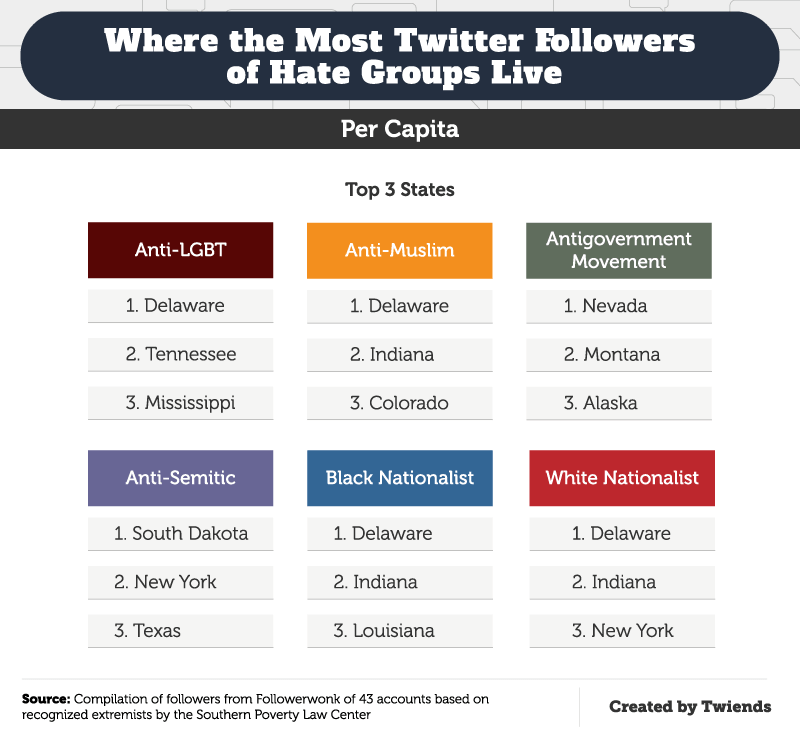
When we consider an extremist's true Twitter influence, measures of engagement indicate their ability to produce meaningful reactions in other users. To determine levels of engagement with each extremist's tweets, we applied a widely used formula : dividing the sum of retweets and replies by the number of followers and multiplying that total by 100. Retweets were excluded.
By this measure, the hate group most capable of inciting engagement was the antigovernment movement, led by vocal proponents such as Larry E. Klayman and Chuck Baldwin. White nationalists also provoked a sizeable Twitter response, thanks in part to the antics of firebrand Peter Brimelow, who had the highest engagement rate of any extremist studied. Brimelow is far from alone in advancing his cause through Twitter, however: Seven of the 15 extremists with the most engagement were white nationalists.
Two anti-Semitic extremists ranked within the top five for engagement as well: Tom Metzger (who employs Twitter handle @terribletommy) and Robert Sungenis. Among anti-LGBT extremists, David Lane generated the most engagement despite his past preference for operating behind the scenes to advance his fundamentalist beliefs.
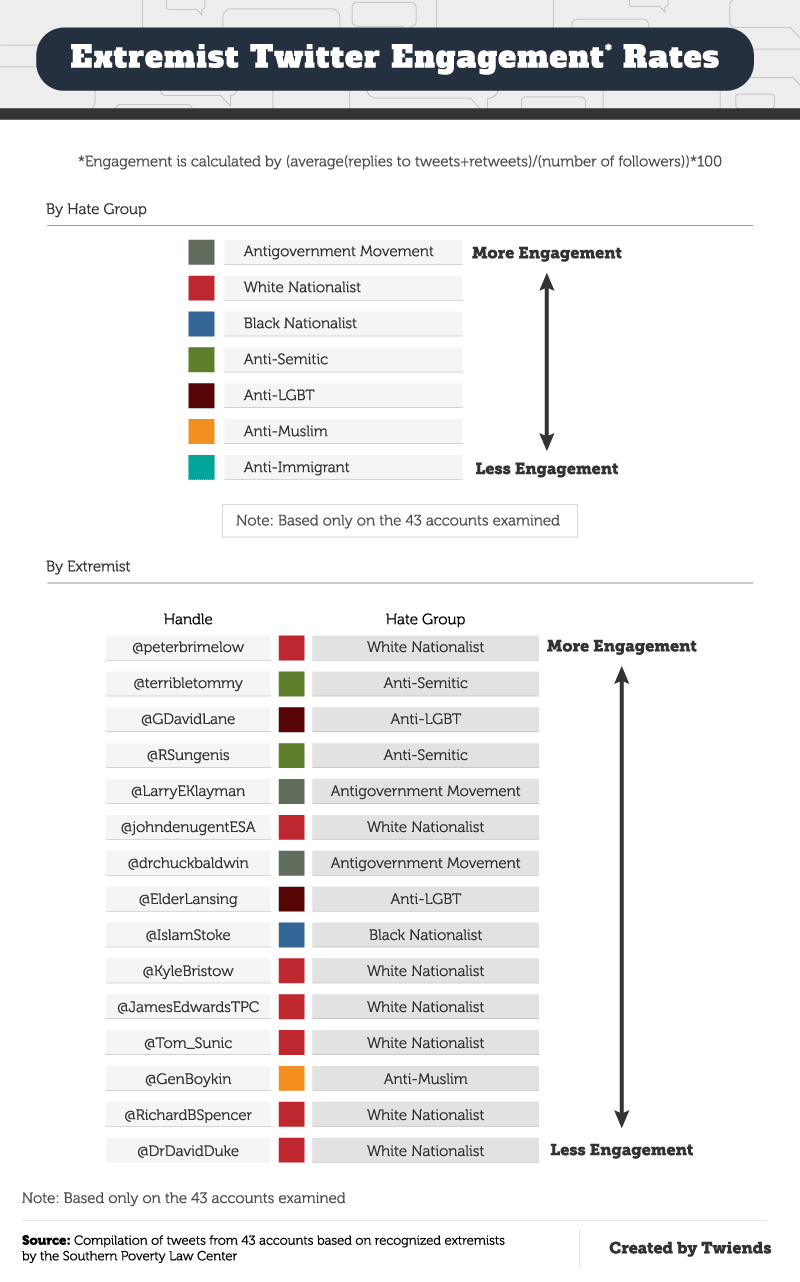
In some respects, the jargon used by these extremists is most striking for its similarity across ideological lines. Some of this common rhetorical ground seems to relate to the Trump administration: Among all ideologies, the third most mentioned word was "Trump," although it could just correlate to the people talking about the president in any manner, not necessarily because he aligns with their beliefs. The first and second mentioned words were "breaking" and "news," respectively.
One of the president's favorite terms also appeared frequently. White nationalists, anti-LGBT, and anti-immigrant extremists all used the phrase "fake news" frequently. Additionally, some extremist ideologies seemed to encourage cults of personality, celebrating specific proponents of their views. Among white nationalists, Richard Spencer and David Duke were mentioned quite often, just as antigovernment adherents talked up Chuck Baldwin and Larry Klayman by name. Enemies were also called out specifically in some cases: Hillary Clinton showed up in antigovernment tweets, while anti-immigrant groups frequently mentioned Ted Cruz.
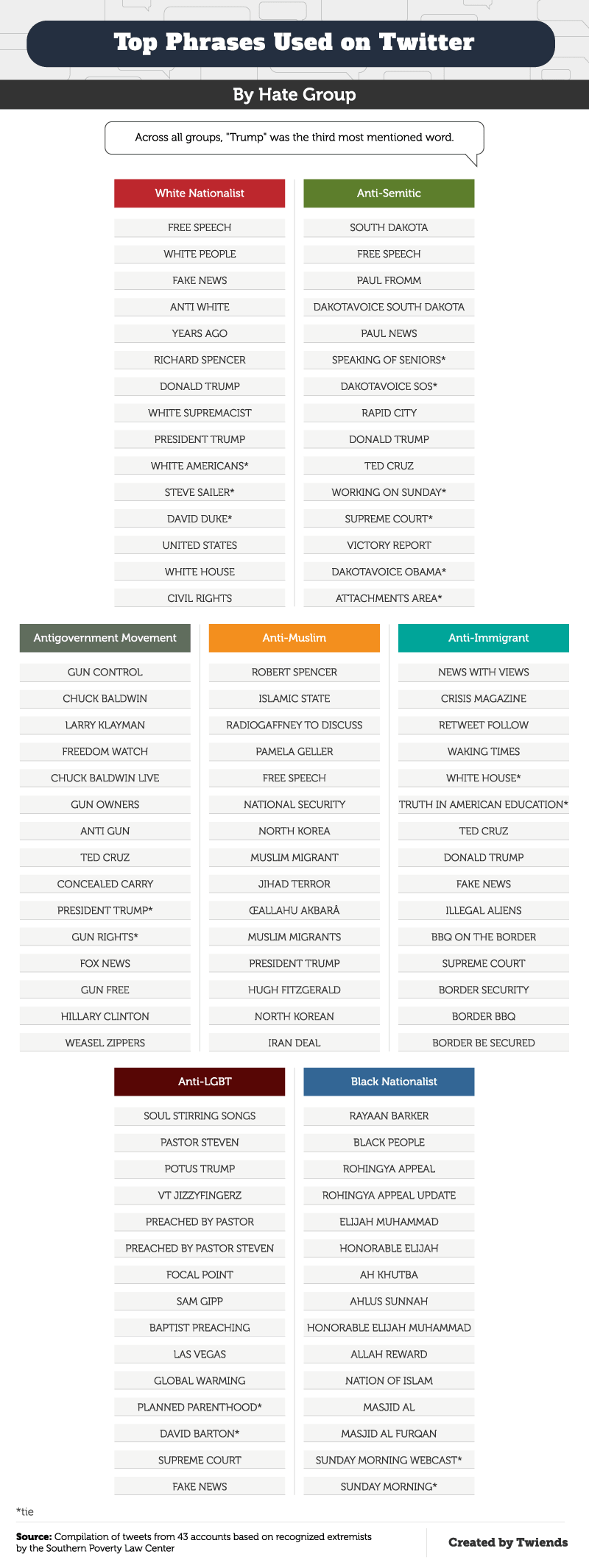
Our findings reveal a concerningly large contingent of extremists using Twitter to advance their hateful views. But although social media can promulgate extreme ideologies, it can also rally citizens who oppose them. Before we dismiss social networks altogether, we must remember their essential power to connect users around the globe. If we employ Twitter as a tool of inclusion, uniting individuals of all backgrounds against extremism, we are honoring the platform's real promise: to influence the global community toward good rather than evil.
If you have a message to share on Twitter, let us help you spread the word. The team at Twiends is dedicated to growing our users' audience of followers, ethically and effectively. From tools to track your exposure to free learning resources, we offer everything you need to expand your impact.
Using the extremist profiles on the Southern Poverty Law Center's website, we pulled a list of extremists and found their Twitter profiles. Not everyone had a Twitter presence; therefore, only the ones we found on Twitter were included in this project.
"Extremist" and "Hate Group" for this project are identified by the Southern Poverty Law Center. The results seen in this project are based on 80,337 tweets from 43 profiles still active on Twitter as of Feb. 27, 2018. Tweets, profile information for each user, and data on hate groups were gathered on Nov. 25, 2017. Information on tweet replies and retweet counts were collected on Jan. 15, 2018.
The users we looked at were:
User Category
AprilintheNorth - Anti-Semitic
BradleeDean1 - Anti-LGBT
BryanJFischer - Anti-LGBT
charlesmurray - White Nationalist
DakotaVoice - Anti-Semitic
DavidBartonWB - Anti-LGBT
drchuckbaldwin -Antigovernment Movement
DrDavidDuke - White Nationalist
ElderLansing - Anti-LGBT
frankgaffney - Anti-Muslim
FrommPaul - Anti-Semitic
GDavidLane - Anti-LGBT
GenBoykin - Anti-Muslim
glennspencer8 - Anti-Immigrant
Hatchet318 - White Nationalist
IslamStoke - Black Nationalist
JamesEdwardsTPC - White Nationalist
jihadwatchRS - Anti-Muslim
johndenugentESA - White Nationalist
JosephFarah - Antigovernment Movement
kevinastrom - Anti-Semitic
KyleBristow - White Nationalist
LarryEKlayman - Antigovernment Movement
larrypratt - Antigovernment Movement
LouEngle - Anti-LGBT
LouisFarrakhan - Black Nationalist
michaelboldin - Antigovernment Movement
PamelaGeller - Anti-Muslim
peterbrimelow - White Nationalist
PoliticalIslam - Anti-Muslim
ramzpaul - White Nationalist
rgarciaq - Anti-Immigrant
RichardBSpencer - White Nationalist
RSungenis - Anti-Semitic
sanderson1611 - Anti-LGBT
Sultanknish - Anti-Muslim
terribletommy - Anti-Semitic
TheMadDimension - White Nationalist
ThomasRobb - Anti-Semitic
Tom_Sunic - White Nationalist
TOOEdit - White Nationalist
tperkins - Anti-LGBT
WBCFredJr - Anti-LGBT
To simplify the hate group ideologies in our Twitter analysis, we grouped some of them. The groupings are as follows:
White Nationalist Anti-Semitic Other
Alt-Right Radical Christian Identity Holocaust Denial
Ku Klux Klan Neo-Nazi
Neo-Confederate Radical Traditional Catholicism
Racist Skinhead
White Nationalist
No additional groupings were done for Other, Anti-Immigrant, Anti-Muslim, Anti-LGBT, Antigovernment Movement, and Black Nationalist.
We used theFollowerwonk service to acquire a sampling of followers for each of these accounts and then analyzed the locations from each of the followers. For the Superlative list of states and ideologies, Washington D.C. was excluded.
To calculate engagement of each of the user's followers, we excluded all retweets the user had posted, anyone with less than 100 followers, and anyone without 100 tweets. The engagement formula was:
( Average(Replies to tweets + Retweets) / Number of Followers ) * 100
To explore phrase frequencies, we used QDA Miner, a text analysis program.
For the text analysis, we only looked at original tweets from each account. Retweets were not included.
We removed the following phrases and words from our analysis:
For the purpose of exploring follower networks, we used Twitter's internal API to pull all of the followers of the 43 accounts explored in this project. The scrape was conducted Jan. 5-16, 2018. The findings of this project have not been statistically tested; therefore, it should be considered for entertainment purposes only.
We invite you to share our content with your own audience for noncommercial purposes. We do ask that you attribute us for our work by providing a link to this page. Ethical sourcing and sharing are important elements of spreading the truth - on Twitter and everywhere else.